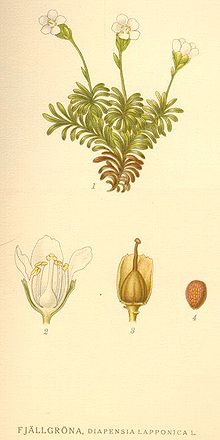Diapensia lapponica
| Diapensia lapponica | |
|---|---|
 |
|
| Scientific classification | |
| Kingdom: | Plantae |
| Clade: | Angiosperms |
| Clade: | Eudicots |
| Clade: | Asterids |
| Order: | Ericales |
| Family: | Diapensiaceae |
| Genus: | Diapensia |
| Species: | D. lapponica |
| Binomial name | |
|
Diapensia lapponica L. |
|
| Subspecies | |
|
|
Diapensia lapponica, the pincushion plant, is a plant in the family Diapensiaceae, the only circumboreal species in the genus Diapensia, the others being mainly in the Himalaya and on mountains in southwestern China. This species likely became Circumboreal-circumpolar [Arctic–alpine] after it jumped to arctic habitat from North China and Russia. The most likely candidate for ancestor is a white-flowered D. purpurea (Day R.T. 2003. Diapensia on Cheju Island, South Korea and Musings on Origins. Sarracenia 11(3):29-31.) The plants grow on exposed rocky ridges that are kept free from snow by high winds. Diapensia is extremely slow and low-growing and cannot compete with plants that over top it. The plant is very sensitive to higher temperatures (global warming a lethal problem in Sweden) and so is often in misty foggy habitat (R. Day thesis). It usually dies when transplanted to lowland gardens (trials in Newfoundland, by R.Day) and so this is not recommended. Cold-treated or wild and winter-collected seed will germinate indoors. The seed and leaves are high in lipids.
It is a small cushion-forming evergreen perennial shrub, up to 15 centimetres (6 in) in height, and can trap heat in the dome (R. Day thesis). It has oval blunt leathery toothless leaves, up to 1 cm (0.4 in) long, which are arranged in dense rosettes. It bears solitary white flowers (rarely pink), on stems up to 3 cm (1.2 in) tall.
It could be aged by counting growth-rings or clump diameter, and on this basis, many Canadian plants are thought to live to over a century or two. See also the thesis by R. Day at Memorial University Newfoundland.
In places such as Newfoundland an early June and later, (often) August blooming period occurs on different plants. Day R.T and Scott P.J. 1981. Autecological aspects of Diapensia lapponica in Newfoundland. Rhodora 83: 101-109. It is not known if this is a genetic or environmental affect. Two blooming periods are known for other plants. It often involves flower buds being formed in the present or previous year (overwintering buds)(see R. Day thesis).
Two subspecies are recognised:
The name Diapensia lapponica was given by Linnaeus to designate a flower found in Lapland, where he traveled early in his career. Linnaeus's book about the flora of Lapland has been called "the first proto-modern flora". However, sources disagree on how Linnaeus might have derived the genus name, Diapensia. Gray states that the term was derived from the ancient Greek name of the Sanicle, a very different looking flower, and opined that the term was "of obscure meaning [and] strangely applied . . . to this boreal plant." Webster's also reflects uncertainty stating the term is "New Latin, perhaps irregular from Greek dia pente by fives + New Latin -ia; from the five-leaved calyx", a description that would apply to thousands of flowering plants. The Encyclopaedia Londinensis of John Wilkes suggested that term is from Greek,"deeply grieving or mourning; probably from its situation".
...
Wikipedia
